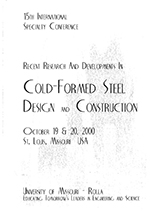Session Dates
19 Oct 2000
Abstract
A common application of cold formed steel in building construction is for wind load bearing steel studs (curtain walls). These wall studs are designed to carry lateral load only, and frame into horizontal steel track members at the top and bottom of the wall assembly. The stud-to-track connection consists of studs framing perpendicularly into the track and are connected with sheet metal screws. The design of the wall stud must include a check of the web crippling capacity at the end reactions. The current design expressions, however, do not apply to the type of bearing in these stud-to-track connections. Reported in this paper are the results and analysis of a collection of end-one-flange web crippling tests of common stud-to-track connections. The analysis shows that there are two failure modes: web crippling of the stud and punch-through of the track flange. Design expressions have been developed to predict the ultimate capacity of the connection based on these two modes of failure. The effects of increasing the gap between the end of the stud and the web of the track, as well as the effects of missing screws in the stud-to-track connection are also discussed.
Department(s)
Civil, Architectural and Environmental Engineering
Research Center/Lab(s)
Wei-Wen Yu Center for Cold-Formed Steel Structures
Meeting Name
15th International Specialty Conference on Cold-Formed Steel Structures
Publisher
University of Missouri--Rolla
Document Version
Final Version
Rights
© 2000 University of Missouri--Rolla, All rights reserved.
Document Type
Article - Conference proceedings
File Type
text
Language
English
Recommended Citation
Schuster, R. M. and Fox, S. R., "Lateral Strength of Wind Load Bearing Wall Stud-to-track Connection" (2000). CCFSS Proceedings of International Specialty Conference on Cold-Formed Steel Structures (1971 - 2018). 3.
https://scholarsmine.mst.edu/isccss/15iccfss/15iccfss-session2/3
Lateral Strength of Wind Load Bearing Wall Stud-to-track Connection
A common application of cold formed steel in building construction is for wind load bearing steel studs (curtain walls). These wall studs are designed to carry lateral load only, and frame into horizontal steel track members at the top and bottom of the wall assembly. The stud-to-track connection consists of studs framing perpendicularly into the track and are connected with sheet metal screws. The design of the wall stud must include a check of the web crippling capacity at the end reactions. The current design expressions, however, do not apply to the type of bearing in these stud-to-track connections. Reported in this paper are the results and analysis of a collection of end-one-flange web crippling tests of common stud-to-track connections. The analysis shows that there are two failure modes: web crippling of the stud and punch-through of the track flange. Design expressions have been developed to predict the ultimate capacity of the connection based on these two modes of failure. The effects of increasing the gap between the end of the stud and the web of the track, as well as the effects of missing screws in the stud-to-track connection are also discussed.



